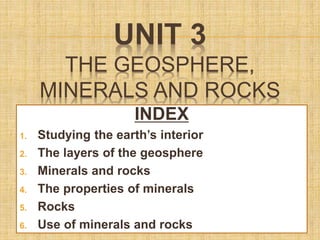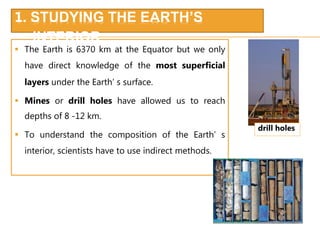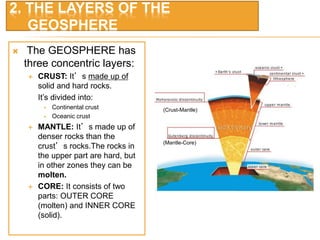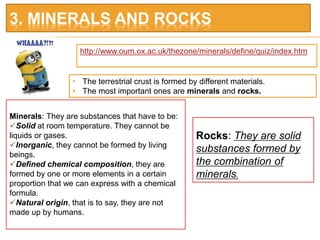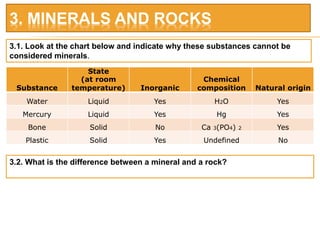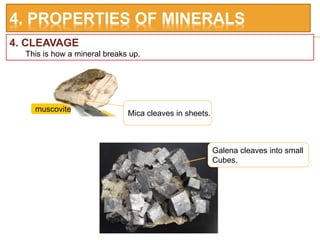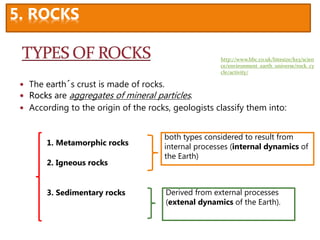UNIT 3-geosphere-1eso.pptx
- 1. UNIT 3 THE GEOSPHERE, MINERALS AND ROCKS INDEX 1. Studying the earthâs interior 2. The layers of the geosphere 3. Minerals and rocks 4. The properties of minerals 5. Rocks 6. Use of minerals and rocks
- 2. VOCABULARY POINT 1 âĒ Drill holes âĒ Seismic âĒ Seismic waves âĒ Seismograph âĒ Speed POINT 2 ï§Crust ï§Mantle ï§Core ï§Molten ï§Outer ï§Inner POINT 3 âĒ Chemical âĒ Formula POINT 4 ï§ Lustre ï§ Dull ï§ Waxy ï§ Glassy ï§ Hardness ï§ Cleavage ï§ Streak POINT 5 ï§ Weathering ï§ Melting ï§ Cooling ï§ Igneous ï§ To beat ï§ To sink ï§ Layer ï§ Molten ï§ To rise up ï§ Towards ï§ Reaching ï§ To be subjected to ï§ Slate ï§ Mable POINT 6 ï§ Plaster ï§ Lead ï§ Native metal âĒ Sondeo âĒ SÃsimico âĒ Ondas sÃsmicas âĒ SismÃģgrafo âĒ Velocidad âĒ Corteza âĒ Manto âĒ NÚcleo âĒ Fundidas âĒ Externo âĒ Interno âĒ QuÃmica âĒ FÃģrmula âĒ MeteorizaciÃģn âĒ FusiÃģn âĒ Enfriado âĒ Ãgneas âĒ Golpear âĒ Hundir âĒ Capas âĒ Fundido âĒ Elevar âĒ Hacia âĒ Alcanzando âĒ Estar sujeto a âĒ Pizarra âĒ MÃĄrmol âĒ Escayola âĒ Plomo âĒ Metal nativo âĒBrillo âĒMate âĒCeroso âĒVÃtreo (cristalino) âĒDureza âĒExfoliaciÃģn âĒRaya
- 3. ï§ The Earth is 6370 km at the Equator but we only have direct knowledge of the most superficial layers under the Earthâ s surface. ï§ Mines or drill holes have allowed us to reach depths of 8 -12 km. ï§ To understand the composition of the Earthâ s interior, scientists have to use indirect methods. 1. STUDYING THE EARTHâS INTERIOR drill holes
- 4. ïž This method analyses the energy generated by earthquakes. ïž When an earthquake occurs, the movement generates waves of energy that travel to the interior of the Earth, called seismic waves. ïž These waves can be detected by an apparatus called a seismograph. ïž This shows us that the speed of the waves vary as they pass from one layer to another. ïž The study of the data obtained from seismographs has allowed scientists to deduce the composition of the Earthâ s interior. 1. STUDYING THE EARTHâS INTERIOR INDIRECT METHODS ï§ The most common method is the study of earthquakes called the seismic method. /saÉŠzmÉŠk/
- 5. 2. THE LAYERS OF THE GEOSPHERE ï The GEOSPHERE has three concentric layers: ï CRUST: Itâs made up of solid and hard rocks. Itâs divided into: ï§ Continental crust ï§ Oceanic crust ï MANTLE: Itâs made up of denser rocks than the crustâs rocks.The rocks in the upper part are hard, but in other zones they can be molten. ï CORE: It consists of two parts: OUTER CORE (molten) and INNER CORE (solid). (Crust-Mantle) (Mantle-Core)
- 6. http://www.oum.ox.ac.uk/thezone/minerals/define/quiz/index.htm 3. MINERALS AND ROCKS Minerals: They are substances that have to be: ïžSolid at room temperature. They cannot be liquids or gases. ïžInorganic, they cannot be formed by living beings. ïžDefined chemical composition, they are formed by one or more elements in a certain proportion that we can express with a chemical formula. ïžNatural origin, that is to say, they are not made up by humans. âĒ The terrestrial crust is formed by different materials. âĒ The most important ones are minerals and rocks. Rocks: They are solid substances formed by the combination of minerals.
- 7. 3. MINERALS AND ROCKS 3.1. Look at the chart below and indicate why these substances cannot be considered minerals. Substance State (at room temperature) Inorganic Chemical composition Natural origin Water Liquid Yes H2O Yes Mercury Liquid Yes Hg Yes Bone Solid No Ca 3(PO4) 2 Yes Plastic Solid Yes Undefined No 3.2. What is the difference between a mineral and a rock?
- 8. 4. PROPERTIES OF MINERALS ï§ They are physical characteristics that can be observed and determined in a simple way. The chemical composition and the disposition of the atoms influence many physical properties: 1. HARDNESS: It is the resistance that the mineral has to being scratched. To define the hardness of a mineral we use the MOSH SCALE OF HARDNESS. Page 31 Ex. 5 & 6
- 9. Mohs Scale Hardness Hardness of Common Objects Talc (softest) 1 Fingernail 2.5 Gypsum 2 Piece of copper 2.5-3.0 Calcite 3 Iron nail 4.5 Fluorite 4 Glass 5.5 Apatite 5 Steel file 6.5 Feldspar 6 Streak plate 7.0 Quartz 7 Flint sandpaper Topaz 8 Spinel (rock shops) Corundum 9 Emery sandpaper Diamond (hardest) 10 Carborundum sandpaper LOW HARDNESS HIGH HARDNESS MEDIUM HARDNESS http://mundo- mineral.blogspot.com.es/search/label/Mag netita
- 10. 4. PROPERTIES OF MINERALS 2. COLOUR: It depends on the light that is absorbed or reflected by the mineral. âĒ Some mineral have always the same color, but others can be different colors because small differences in their chemical composition, such as quartz. white or transparent halite different colours quartz waxy talc dull to glassy feldspars metallic pyrite glassy quartz 3. LUSTRE: /lĘstÉĘģ/ The way a mineral reflects light.
- 11. 4. PROPERTIES OF MINERALS 4. CLEAVAGE This is how a mineral breaks up. muscovite Mica cleaves in sheets. Galena cleaves into small Cubes.
- 12. ï The earthÂīs crust is made of rocks. ï Rocks are aggregates of mineral particles. ï According to the origin of the rocks, geologists classify them into: 1. Metamorphic rocks 2. Igneous rocks 3. Sedimentary rocks http://www.bbc.co.uk/bitesize/ks3/scien ce/environment_earth_universe/rock_cy cle/activity/ both types considered to result from internal processes (internal dynamics of the Earth) Derived from external processes (extenal dynamics of the Earth). 5. ROCKS
- 13. SEDIMENTARY ROCK IGNEOUS ROCK METAMORPHIC ROCK weathering and erosion compaction and cementation melting cooling SEDIMENTS MAGMA http://www.students.linguaframe.com/04b- rocks 5. ROCKS
- 14. Formation of sedimentary rocks Wind and moving water beat away fragments of rocks and transport them. The fragments sink to the sea floor as sediment. Over time they build up and form layers. When many layers are formed, the lower layers of sediment are compacted by the upper layers and are transformed into sedimentary rocks. 1 2 3 Limestone Examples of sedimentary rocks Conglomerate Sandstone 5. ROCKS A. SEDIMENTARY ROCKS
- 15. Formation of magmatic rocks Magma (very hot masses of molten minerals) rises up slowly through the lithosphere towards the Earthâs surface. The magma that reaches the surface through volcanoes cools down quickly and forms VOLCANIC ROCKS. The magma that does not reach the surface cools down slowly and forms PLUTONIC ROCKS. 1 2 3 http://recursos.cnice.mec.es/biosfera/alumno/2ESO/tierrin/actividades/rocas1.htm http://recursos.cnice.mec.es/biosfera/alumno/2ESO/tierrin/actividades/act16.htm http://roble.pntic.mec.es/~hotp0039/jaznar/Hibrida.htm 5. ROCKS B. IGNEOUS ROCKS GRANITE BASALT
- 16. ï They are created from rocks which are crushed (high pressures) and/or exposed to high temperatures inside the crust, but they DONâT MELT. Some rocks inside the lithosphere are subjected to great pressures and high temperatures. High pressure and temperatures cause changes in these rocks that turn them into metamorphic rocks. 1 2 5. ROCKS C. METAMORPHIC ROCKS SLATE GNEISS MARBLE
- 17. 6. USES OF MINERALS AND ROCKS Minerals are used in: âĒ MEDICINE: Gypsum to make plaster. âĒ CONSTRUCTION: ïž Metals such as iron (Fe) and lead (Pb), ïž calcite to make cement, ïž quartz to make glass and electrical components. âĒ JEWELLERY: Gems as diamonds or native metals, such as gold and silver. USE OF MINERALS
- 18. 6. USES OF MINERALS AND ROCKS Rocks are used in: âĒ CONSTRUCTION: ïž Clay to make bricks and ceramics ïž Stones ïž Marble and granite for urban furniture and sculptures âĒ ENERGY PRODUCTION: Coal and oil. âĒ PLASTICS: Produced from oil. USE OF ROCKS

